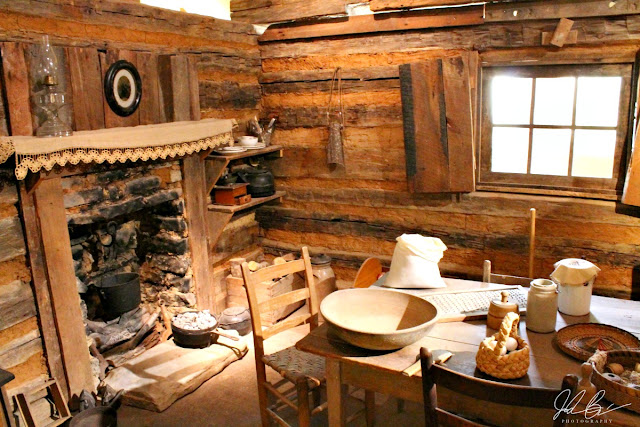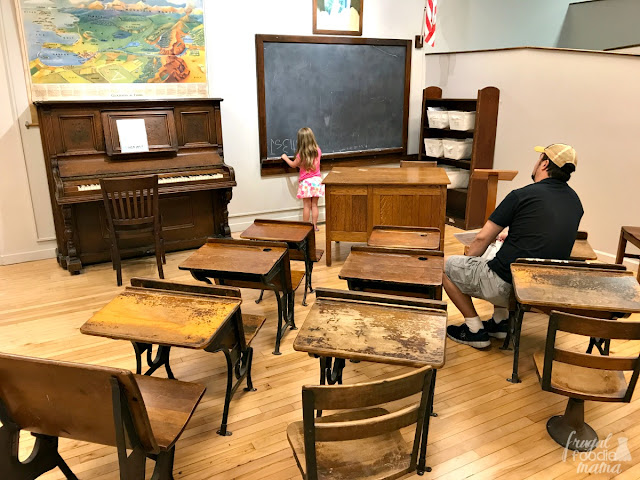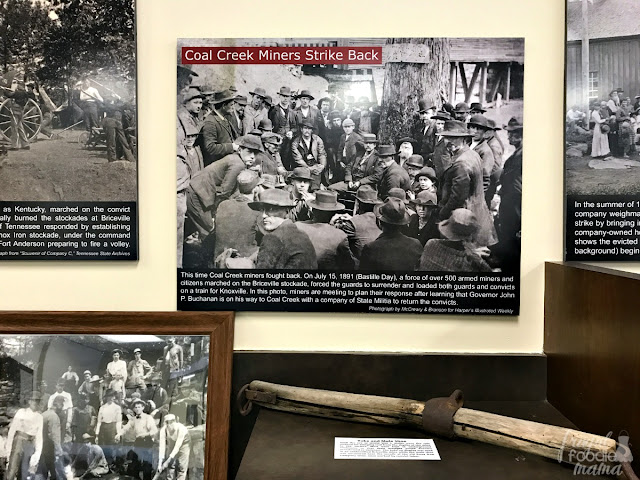These 6 Hands-On History Museums in Anderson County, Tennessee really bring the history of this southern Appalachian region & its people to life...
This post was created in partnership with Adventure Anderson County. As always, all opinions & thoughts expressed below are 100% my own.
The Anderson County area in eastern Tennessee is a region with a rich & diverse local history. From the early days of Appalachian living to the coal mining disasters & wars to it's place in history as one of only 3 secretive & heavily guarded locations of the Manhattan Project during World War II, Anderson County is a history buff's dream come true. Drawing on its role as a pivotal player in the country's & the region's history, this area is home to many amazing museums & historical locations.
During our visit to Tennessee earlier this summer, my family & I got to experience 6 hands-on history museums that really brought the history of Anderson County & its people to life. These museums encouraged its patrons to touch, to explore, to ask questions, & to really immerse themselves in the historical narrative of eastern Tennessee.
I firmly believe that now more than ever it is important for families to visit places of historical significance and to explore our nation's past & to have these pivotal conversations about where we have been as a country, where we are as a country, & in which direction we would like to head in as a nation now.
1. Museum of Appalachia (2819 Andersonville Highway, Clinton)
Admission: $18 for adults, $10 for youth (13-18), $6 for children (5-12), FREE for children under 5. They also offer a more affordable family rate of $42 that includes 2 adults & 2 children.
Take a walk through what life in early Appalachia would have looked like as you and your family explore the 35 historic log cabins, barns, churches, schools, gardens, and farm land located on the 65 acres that comprise the Museum of Appalachia.
The museum started in 1969 with just one log cabin & one man's dream to collect and preserve the history of Tennessee's Appalachian region for future generations. Thanks to the efforts of Mr. Irwin, thousands of visitors each year are able to browse over 250,000 authentic artifacts & to experience first hand how an Appalachian village may have looked like.
A few of our favorite exhibits from our visit to the Museum of Appalachia were the Mark Twain Family Cabin (although Twain was not born in the cabin, it was his family's cabin in Tennessee prior to his birth), the Carter family (as in the June Carter) display in the Appalachian Hall of Fame barn, & the covered porch & main stage where we were treated to a little live blue grass music during our visit.
Photo credit: Jake Bice Photography
The living history museum also happens to be home to various farm animals such as sheep, chickens, & even peacocks. If you are lucky, one of the peacocks may even show off and put on a little show for you. ;)
If you happen to have worked up an appetite after exploring the grounds of the museum, then be sure to stop in at the museum restaurant for a home cooked, southern style lunch. Open from 11am to 3pm, the restaurant is located on the first floor of the gift shop & serves weekly specials. I highly recommend a bowl of the pinto beans with a toasted pimento cheese sandwich. :)
2. Green McAdoo Cultural Center (101 School Street, Clinton)
Admission is FREE.
Though overshadowed by the events at Little Rock at the time, Clinton High School in Anderson County, TN was actually the first state-supported high school to desegregate in the south. On August 27, 1956, a dozen African American students walked into the high school for their first day of school & forever became known as the Clinton 12. Today you can walk through the actual building where the high school was located & learn the story of these 12 brave young people that is now preserved & memorialized at the cultural center.
The Green McAdoo Cultural Center takes you on an exploration of how Jim Crow laws affected African American students in eastern Tennessee, the events that led to the desegregation of Clinton High School, and how the entire community stood together in the face of pressure & hatred from the outside and refused to back down. It is a truly inspiring story that is such an important reminder given the current events in our country right now.
3. Children's Museum of Oak Ridge (461 West Outer Drive, Oak Ridge)
Admission: $7 for adults, $5 for children 3-17, Children 2 & under are FREE
Photo credit: Jake Bice Photography
In the Mars Rocket Room, the kiddos can pose for photos on the Mars landscape & even "blast off" in the newly refurbished & updated rocket.
After your little one has thoroughly explored Mars, take a trip back to 1942 when Oak Ridge became one of only three sites in the United States to secretly work on the Manhattan Project, aka the atomic bomb that would eventually bring an end to World War II. The kids can climb up a reproduction guard tower (no one could get in or out of the Secret City without proper credentials & the area was heavily guarded), see what the living space in one of the homes would have looked like then, and what it was like to be a kid growing up in such a secretive town.
One of my daughter's favorite exhibits in the museum was the 1930's schoolroom. The room is a full scale replica of what a classroom may have looked like during the 30's. Needless to say, she wrangled in her father as a pupil. ;)
4. American Museum of Science & Energy (300 South Tulane Avenue, Oak Ridge)
Admission: $5 for adults, $3 for children 6-17, children 5 & under are FREE
Although the American Museum of Science & Energy is definitely a hands-on science museum for the most part, a good portion of the museum also happens to be dedicated to the history & story of Oak Ridge as part of the Manhattan Project during World War II. There is an extensive exhibit dedicated to the role that Y-12 (a plant that was built in the Secret City & that is still in operation today) has played & continues to play in our national defense. But I think the coolest exhibit that they currently have at the museum involving Oak Ridge's WWII past is the original flattop house that you can walk through & tour...
The Secret City was built almost literally overnight. To save money & time, almost all of the single-family homes for its 75,000 residents were prefabricated & brought in from an Indiana factory. This particular flattop home is an original 574 square foot, 2 bedroom & 1 bath home that was donated to the museum. Most of the furnishings in the home are original really giving you an authentic feel of what a home would have looked like in the Secret City in 1945.
This 20 foot tall "World Trade Center: Sculpture of Steel" sculpture is located outside of the museum.
5. Coal Creek Miners Museum (201 South Main Street, Rocky Top)
Admission is FREE.
Another pivotal piece of Anderson County's history revolves around the area's role in coal mining in the Appalachian region. Documenting life in the mine towns and the upheaval & loss from mining disasters & mine wars, the Coal Creek Miners Museum is one of the only museums in Anderson County dedicated exclusively to the mining history of the area. A museum curator/local historian is always on hand to personally guide you through the one room museum.
Learn how these communities pulled together & survived after two of the greatest mining disasters in United States history. Hear stories of how the miners fought back against the oppressive & often unfair mine companies.
Then head back to your car to follow the Motor Discovery Trail of Coal Creek, Tennessee...
Take the short drive from the museum to the site of where Fort Anderson once stood on Militia Hill. The soldiers were brought in by the state of Tennessee to restore order & control during the Coal Creek War of 1886. This war was being waged by the local miners after the coal companies started using convict labor to replace them during miner strikes. The war ended with the state ending its convict lease system.
6. Lenoir Museum Cultural Complex (2121 Norris Freeway, Norris)
Admission is FREE.
Photo credit: Jake Bice Photography
The Lenoir Museum located within the Norris Dam State Park is an extensive two story curated collection of artifacts depicting life in southern Appalachia from 12,000 years ago all the way up to present day. Will & Helen Lenoir collected Americana artifacts for over 60 years & eventually donated these items to the state. The state of Tennessee, in turn, opened the Lenoir Museum Cultural Complex to display these artifacts & honor the preservation efforts of the Lenoirs.
Photo credit: Jake Bice Photography
The cultural complex also includes the Rice Gristmill (pictured above) that was originally built in 1798 & then dismantled & reconstructed in 1935 where it stands today at the head of the Clear Creek trail. Across from the gristmill, you can also walk through the Caleb Crosby Threshing Barn that was originally built in the 1830's & moved to its present location in Norris Dam State Park in 1978.
Which of these 6 Hands-On History Museums will you be adding first to your Anderson County travel itinerary? :)
For more information & to start planning your family outdoor adventure soon, be sure to visit the Adventure Anderson County website!
Looking for a family friendly hotel to stay at during your visit to Anderson County? Then be sure to book a room at the Holiday Inn Express in Clinton. They offer 2 bedroom suites (perfect for families!) as well as a free continental breakfast each morning of your stay. The kids loved their indoor/outdoor pool as well.
If you loved this post, then you might also like my...

If you loved this post, then you might also like my...
Want to follow along with all of our family travel adventures?

























